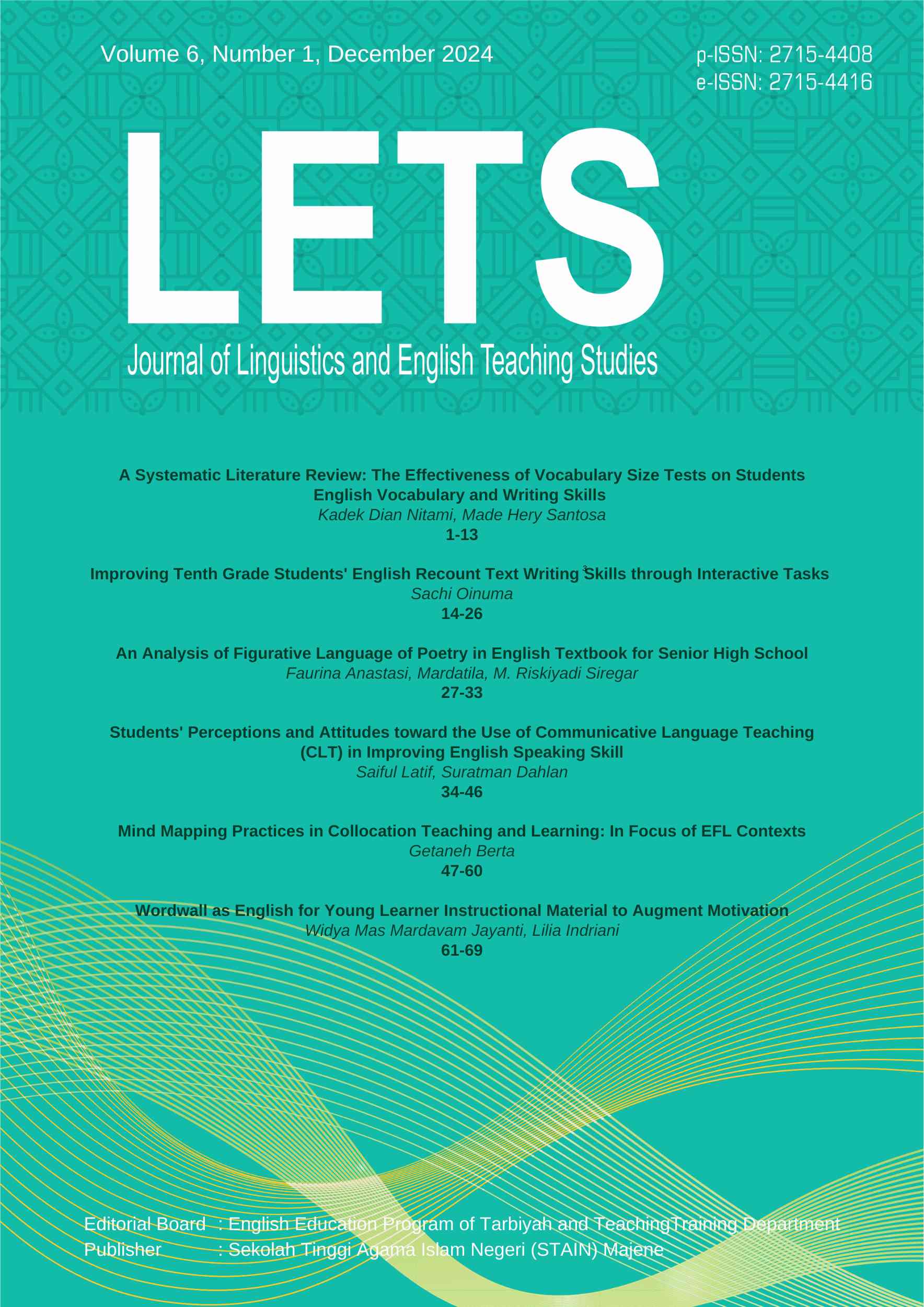A Systematic Literature Review: The Effectiveness of Vocabulary Size Tests on Students English Vocabulary and Writing Skills
DOI:
https://doi.org/10.46870/lets.v6i1.1002Keywords:
Language Learning, Vocabulary Size Test Website, Writing SkillsAbstract
This research aims to examine the benefits of integrating vocabulary size test in the context of learning English learners as well as the relationship between vocabulary and writing skills. Using the systematic literature review (SLR) method, this research analyzed 18 selected articles published between 2019-2024. The results of the research show that the web-based vocabulary measurement is proven to be effective and efficient in measuring the Vocabulary of English students. Its advantages include accessibility, time efficiency and ease of use. In addition, a strong positive correlation was found between vocabulary and students' writing skills at various levels of education. The integration of this technology not only increases student learning motivation but also has the potential to strengthen students’ writing skills. In conclusion, developing a vocabulary size test website is an important strategy in modern English language learning since it facilitates increased mastery of vocabulary which ultimately supports the development of students' writing skills.
References
Alam, G. M., & Forhad, M. A. R. (2023). The impact of accessing education via smartphone technology on education disparity—a sustainable education perspective. MDPI Journals, 15(14), 2–14. https://doi.org/10.3390/su151410979
Asyiah, D. N. (2017). The Vocabulary teaching and vocabulary learning: perception, strategies, and influences on students’ vocabulary mastery. Jurnal Bahasa Lingua Scientia, 9(2), 294–318. https://doi.org/10.21274/ls.2017.9.2.293-318
Barus, K. H. B. B., & Panjaitan, N. B. (2022). The correlation between vocabulary mastery and writing skill a Meta-Analysis. Channing: Journal English Language Education and Literature, 7(1), 13–20. https://e-journal.unmas.ac.id/index.php/ajoes/article/download/4590/3609/10434
Bhowmik, S. (2021). Writing instruction in an EFL context: learning to write or writing to learn language? BELTA Journal, 5(1), 30–42. https://doi.org/10.36832/beltaj.2021.0501.03
Chen, P.-H., Hulme, R. C., Blott, L. M., & Rodd, J. M. (2024). The web-based open-access reliable decision on synonyms (WORDS) English vocabulary test. JALT Publication, 31(7), 9–13. https://doi.org/10.31234/osf.io/7fa3h
Dwijanatha, D. M. M., Wiryadi Joni, D. A. A., & Krismayani, N. W. (2022). The correlation between vocabulary mastery and descriptive writing ability of the tenth-grade students. JOSELT (Journal on Studies in English Language Teaching), 3(2), 28–33. https://e-journal.unmas.ac.id/index.php/joselt/issue/view/288
Endarto, I. T., & Subekti, A. S. (2020). Developing a web-based vocabulary size test for Indonesian EFL learners. Jurnal Bahasa Dan Sastra, 18(2), 72–81. https://doi.org/10.33365/ts.v18i2.492
Gs, G., Astuti, R. D., & Indriyani, A. (2020). The relationship between students’ vocabulary mastery and their writing skills. Journal Elang and English Education, 5(1), 5–22. https://ejournal.unibba.ac.id/index.php/elang/article/view/783
Haerazi, H., & Kazemian, M. (2021). Self-regulated writing strategy as a moderator of metacognitive control in improving prospective teachers’ writing skills. Journal of Language and Literature Studies, 1(1), 1–14. https://doi.org/10.36312/jolls.v1i1.498
Husnanissa, A. (2020). Measuring English students’ vocabulary size at the first semester of the eighth grade of SMPN 5 Bandar Lampung in the academic year of 2017/2018.
Juniantini, L. A., Santosa, M. H., & Kusuma, I. I. P. (2024). Enacting an artificial intelligence-based learning media to support vocabulary mastery at SMA Negeri 2 Gerokgak: a mixed methods study. Jurnal JOEPALLT, 12(1), 1–15. https://jurnal.unsur.ac.id/jeopallt
Keng, S. H. (2024). The effect of soft skills on academic outcomes. B.E. Journal of Economic Analysis and Policy, 24(1), 35–67. https://doi.org/10.1515/bejeap-2022-0342
Kumar, A., Singh, P. N., Ansari, S. N., & Pandey, S. (2022). Importance of soft skills and its improving factors. World Journal of English Language, 12(3), 220–227. https://doi.org/10.5430/wjel.v12n3p220
Limbong, A. E. U., Raja, V. L., & Sari, A. S. P. (2020). The correlation between the students’ vocabulary mastery and their writing skill of the tenth grade students of SMA Negeri 1 Kerajaan in the academic year of 2020/2021. KAIROS ELT Journal, 4(2), 2580–4278. https://www.ejournal.ust.ac.id/index.php/KAIROS/article/view/1140
M Elvina, J., Atmanegara, Y., & Putri, N. (2022). The correlation between students’ vocabulary mastery and writing descriptive text ability of the eight grade students in SMP Negeri 40 Palembang. Literal: English Teaching and Learning Journal, 1(1), 17–27. https://doi.org/10.19109/literal.v1i1.12828
Mahmudah, R. D. (2014). The correlation between students’ writing ability and their vocabulary mastery. English Education Department, 3(2), 193–206. https://dx.doi.org/10.26618/ejpbi.v3i2.837
Nunan, David. (2003). Practical english language teaching. McGraw-Hill/Contemporary.
Puspitasari, M., Ratminingsih, N. M., & Santosa, M. H. (2024). The contribution of EFL students’ vocabulary mastery and motivation to writing ability of eighth-grade students at Smpn 5 Denpasar. J-SHMIC : Journal of English for Academic , 11(1), 63–76. https://journal.uir.ac.id/index.php/jshmic
Putra, M. A. M., & Santosa, M. H. (2020). Mobile assisted language learning in intensive english course for freshmen year students. Journal of Education Technology, 4(2), 127–132. https://doi.org/10.23887/jet.v4i2.25097
Putri, S. A. M. D. U., Ratminingsih, N. M., & Santosa, M. H. (2023). A Systematic Review on Cake Application for Students’ Learning Motivation and Vocabulary Mastery. Jurnal of English Development, 3(02), 139–153. https://doi.org/10.25217/jed.v3i01.3533
Ramzan, M., Mushtaq, A., Ashraf, Z., & Scholar, P. (2023). Evacuation of difficulties and challenges for academic writing in ESL Learning. University of Chitral Journal of Linguistics & Literature, 7(1), 43–49. https://jll.uoch.edu.pk/index.php/jll/index
Rizka Novitri, M., Budiman, T. C. S., & Hawa, F. (2021). The correlation between vocabulary mastery and their ability in writing descriptive text. Journal of English Language Learning (JELL), 5(2), 33–45. https://dx.doi.org/10.31949/jell.v5i2.3341
Safriyani, R. (2019). Designing a computer-based test version of a vocabulary test. JELTII Journal of English Language Teaching and Islamic Integration, 2(2), 185–205. https://e-journal.hikmahuniversity.ac.id/index.php/jeltii/article/view/52
Santosa, M. H., Pratama, I. P. S., & Putra, I. N. A. J. (2020). Developing Android-based English vocabulary learning materials for primary school students. Journal of English Education and Linguistics Studies, 7(1), 161–185. https://doi.org/10.30762/jeels.v7i1.1467
Susanto, A. (2017). The teaching of vocabulary: a perspective. Jurnal KATA, 1(2), 182–191. http://dx.doi.org/10.22216/jk.v1i2.2136
Syartika, W., Suhani, S., & Sevrika, H. (2020). Correlation between students’ writing ability in descriptive text and their vocabulary mastery. CURRICULA: Journal Of Teaching and Learning, 5(1), 39–49. https://doi.org/10.22216/jcc.2020.v5i1.1539
Tanaka, J. (2018). Sharing vocabulary size test scores with students: what’s the impact on motivation? PASAA, 55(1), 78–99. https://doi.org/10.58837/CHULA.PASAA.55.1.4
Tri Harli, Y., Sartika, D., & Amelia, K. R. (2024). The relationship between the eight-grade students’ vocabulary mastery and their writing achievement at SMP PGRI Pedamaran. Language and Education Journal, 9(1), 125–138. https://doi.org/10.52237/lej.v9i1.727
Troia, G. A., Lawrence, F. R., Brehmer, J. S., Glause, K., & Reichmuth, H. L. (2023). Efficient measurement of writing knowledge with forced-choice tasks: preliminary data using the student knowledge of writing test. Journal of Writing Research, 15(2), 1–33. https://doi.org/10.17239/jowr-2023.15.02.06
Tsuraya, A. S., Atmowardoyo, H., & Salija, K. (2018). A cross-sectional study on vocabulary size among different levels of the university students. Journal Of English Language Teaching, 5(1), 58–66. https://doi.org/10.26858/eltww.v5i1.5774
Wiguna, I. G. A. B. M., Wirastuti, I. G. A. P., & Widhiasih, L. K. S. (2021). The correlation between vocabulary mastery and writing ability. Academic Journal on English Studies, 1(2), 94–101. https://e-journal.unmas.ac.id/index.php/ajoes/article/download/4590/3609/10434
Winardi, Y. (2023). Using oas.web.id to create English vocabulary size quiz. POLYGLOT: Journal Ilmiah, 19(1), 41–56. https://doi.org/10.1966/pji.v19i1.5703
Wulansari, A. D., Kirana, D. P., & Mufanti, R. (2023). Development of a computerized-adaptive test to measure English vocabulary size with IRT. Indonesian Journal on Learning and Advanced Education (IJOLAE), 5(3), 277–294. https://doi.org/10.23917/ijolae.v5i3.22953
Xia, T., Chen, X., Parsaei, H. R., & Qiu, F. (2023). An intelligent vocabulary size measurement method for second language learner. Language Testing in Asia, 13(1), 13–45. https://doi.org/10.1186/s40468-023-00258-w
Yasmini, N. K. A., Wiradi Joni, D. A. A., & Kumara, D. G. A. G. (2022). The correlation between vocabulary mastery and descriptive paragraph writing ability of the eight grade students. Academic Journal on English Studies, 2(2), 115–120. https://e-journal.unmas.ac.id/index.php/ajoes/article/view/5916
Yuliastiani, E., Supriyono, S., Wicaksono, A., & Tommy Hastomo. (2021). The correlation between vocabulary mastery, reading habits, and the students’ writing ability. IJLHE: International Journal of Language, Humanities and Education, 3(1), 69–76. https://doi.org/10.52217/ijlhe.v3i1
Downloads
Published
Issue
Section
License
Copyright (c) 2024 Kadek Dian Nitami, Made Hery Santosa

This work is licensed under a Creative Commons Attribution-ShareAlike 4.0 International License.












